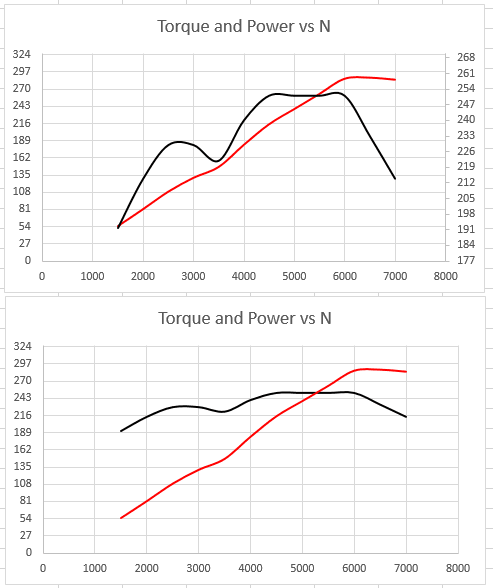richardK69
Automotive
- Mar 20, 2007
- 1
Hello,
Why doesn't the Power curve for a typical set of Power and Torque curves for an ICE (or any engine for that matter) show deviations more pronounced than it's corresponding Torque curve? P=T*omega and omega increases linearly along the x axis so therefore shouldn't any deviations on the T curve be seen on the corresponding P curve but with a greater amplitude (since they're being multiplied by omega)? The further to the right on the graph you go the greater omega becomes and hence the more pronounced the deviations should be seen on the P curve.
For example if you look at this set of curves the dip on the torque curve at 3500 should be even more pronounced on the P curve at the same RPM, but it isn't.
Or this set of curves: where for the torque peak at 3000 rpm the P curve hardly shows any deviation.
It's as if the omega is less than one, i.e. reducing the amplitude?
Any clarification would be most appreciated.
Rgs,
Why doesn't the Power curve for a typical set of Power and Torque curves for an ICE (or any engine for that matter) show deviations more pronounced than it's corresponding Torque curve? P=T*omega and omega increases linearly along the x axis so therefore shouldn't any deviations on the T curve be seen on the corresponding P curve but with a greater amplitude (since they're being multiplied by omega)? The further to the right on the graph you go the greater omega becomes and hence the more pronounced the deviations should be seen on the P curve.
For example if you look at this set of curves the dip on the torque curve at 3500 should be even more pronounced on the P curve at the same RPM, but it isn't.
Or this set of curves: where for the torque peak at 3000 rpm the P curve hardly shows any deviation.
It's as if the omega is less than one, i.e. reducing the amplitude?
Any clarification would be most appreciated.
Rgs,

